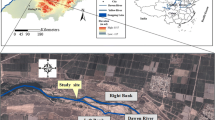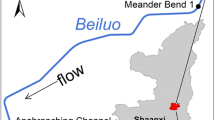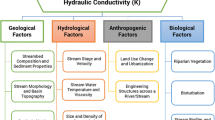Abstract
Streambed vertical hydraulic conductivity (K v ) plays an important role in understanding and quantifying the stream–aquifer interactions. While several researchers have discussed the spatial variability of streambed horizontal hydraulic conductivity or K v at one or several close-located sites in a river, they did not develop any statistical distribution analysis of streambed K v at distant sites along a large river. In this paper, the statistical distribution and spatial variation of streambed K v at 18 test sites in a 300-km reach of the Platte River in Nebraska are presented. In-situ permeameter tests using the falling-head method were carried out to calculate the streambed K v values. Fine-grained sediments transported by two tributaries, the Loup River and the Elkhorn River, to the Platte River appear to result in lower streambed K v values downstream of the confluences between the Platte River and the tributaries. The streambed K v values were found to be normally distributed at nearly each test site. When the correlated K v values were eliminated from the grid sampling plots, the remaining independent sub-datasets of streambed K v values were still in normal distribution at each test site. Furthermore, the combined streambed K v values upstream of the first confluence between the Platte River and the Loup River was normally distributed, which may be due to the lack of tributaries in-between and thus streambed sediments were well distributed in this reach and belonged to a single population of hydraulic conductivity values. In contrast, the combined dataset of all measurements conducted downstream of this confluence was no longer in normal distribution, presumably as a result of the mixing of different sediment sources.
Similar content being viewed by others
References
Bjerg PL, Hinsby K, Christense TH, Gravesen P (1992) Spatial variability of hydraulic conductivity of an unconfined aquifer determined by a mini slug test. J Hydrol 136:107–122
Cardenas MB, Zlotnik VA (2003) Three-dimensional model of modern channel bend deposits. Water Resour Res 39:1441. doi:10.1029/2002WR001383
Chen XH (2000) Measurement of streambed hydraulic conductivity and its anisotropy. Environ Geol 39(12):1317–1324
Chen XH (2004) Streambed hydraulic conductivity for rivers in south-central Nebraska. J Am Water Resour Assoc 40(3):561–574
Chen XH (2005) Statistical and geostatistical features of streambed hydraulic conductivities in the Platte River, Nebraska. Environ Geol 48(6):693–701
Chen XH (2007) Hydrologic connections of a stream-aquifer-vegetation zone in south-central Platte River valley, Nebraska. J Hydrol 333:554–568. doi:10.1016/j.jhydrol.2006.09.020
Chen XH, Shu L (2002) Stream-aquifer interactions: evaluation of depletion volume and residual effects from ground water pumping. Ground Water 40(3):284–290
Chen XH, Burbach M, Cheng C (2008) Electrical and hydraulic vertical variability in channel sediments and its effects on streamflow depletion due to groundwater extraction. J Hydrol 352(3–4):250–266
Chen XH, Song J, Cheng C, Wang D, Lackey SO (2009) A new method for mapping variability in vertical seepage flux in streambeds. Hydrogeol J 17(3):519–525. doi:10.1007/s10040-008-0384-0
Cheng C, Chen XH (2007) Evaluation of methods for determination of hydraulic properties in an aquifer-aquitard system hydrologically connected to a river. Hydrogeol J 15:669–678
Freeze RA (1975) A stochastic-conceptual analysis of one-dimensional groundwater flow in a nonuniform homogeneous media. Water Resour Res 11(5):725–742
Frings RM (2008) Downstream fining in large sand-bed rivers. Earth-Sci Rev 87:39–60
Genereux DP, Leahy S, Mitasova H, Kennedy CD, Corbett DR (2008) Spatial and temporal variability of streambed hydraulic conductivity in West Bear creek, North Carolina, USA. J Hydrol 358:332–353
Goovaerts P (1997) Geostatistics for Natural Resources Evaluation. Oxford University Press, New York, p 483
Goswami D, Kalita PK, Mehnert E (2010) Modeling and simulation of baseflow to drainage ditches during low-flow periods. Water Resour Manag 24:173–191
Hess KM, Wolf SH, Celia MA (1992) Large-scale natural gradient tracer test in sand and gravel, Cape Cod, Massachusetts 3. Hydraulic conductivity variability and calculated macrodispersitivities. Water Resour Res 28(8):2011–2027
Hoey TB, Bluck BJ (1999) Identifying the controls over downstream fining of river gravels. J Sediment Res 69(1):40–50
Huntzinger TL, Ellis MJ (1993) Central Nebraska river basins, Nebraska. J Am Water Resour Assoc 29(4):533–574
Hvorslev MJ (1951) Time lag and soil permeability in ground-water observations. US Army Corps of Engineers, Waterways Experiment Station Bulletin 36:1–50
Kalbus E, Reinstorf F, Schirmer M (2006) Measuring methods for groundwater, surface water and their interactions: a review. Hydrol Earth Syst Sci 10:873–887
Kalbus E, Schmidt C, Molson JW, Reinstorf F, Schirmer M (2009) Influence of aquifer and streambed heterogeneity on the distribution of groundwater discharge. Hydrol Earth Syst Sci 13:69–77
Kelly SE, Murdoch LC (2003) Measuring the hydraulic conductivity of shallow submerged sediments. Ground Water 41(4):431–439
Kennedy CD, Genereux DP, Corbett DR, Mitasova H (2009) Spatial and temporal dynamics of coupled groundwater and nitrogen fluxes through a streambed in an agricultural watershed. Water Resour Res 45:W09401 doi:10.1029/2008WR007397
Landon MK, Rus DL, Harvey FE (2001) Comparison of instream methods for measuring hydraulic conductivity in sandy streambeds. Ground Water 39(6):870–885
Leek R, Wu JQ, Wang L, Hanrahan TP, Barber ME, Qiu H (2009) Heterogeneous characteristics of streambed saturated hydraulic conductivity of the Touchet River, south eastern Washington, USA. Hydrol Process 23:1236–1246
Mason JA (2001) Transport direction of Peoria loess in Nebraska and implications for loess sources on the central Great Plains. Quat Res 56:79–86
Muhs DR (2004) Mineralogical maturity in dunefields of North America, Africa and Australia. Geomorphology 59:247–269
Rehfeldt KR, Boggs JM, Gelhar LW (1992) Field study of dispersion in a heterogeneous aquifer 3. Geostatistical analysis of hydraulic conductivity. Water Resour Res 28(12):3309–3324
Rice S (1998) Which tributaries disrupt downstream fining along gravel-bed rivers? Geomorphology 22:39–56
Rice S, Church M (1998) Grain size along two gravel-bed rivers: statistical variation, spatial pattern and sedimentary links. Earth Surf Processes Landf 23:345–363
Ryan RJ, Boufadel MC (2007) Evaluation of streambed hydraulic conductivity heterogeneity in an urban watershed. Stoch Environ Res Risk Assess 21:309–316
Salehin M, Packman AI, Paradis M (2004) Hyporheic exchange with heterogeneoys streambeds: laboratory experiments and modeling. Water Resour Res 40:W11504. doi:10.1029/2003WR002567
Singer MB (2008) Downstream patterns of bed material grain size in a large, lowland alluvial river subject to low sediment supply. Water Resour Res 44:W12202. doi:10.1029/2008WR007183
Song J, Chen XH, Cheng C, Summerside S, Wen F (2007) Effects of hyporheic processes on streambed vertical hydraulic conductivity in three rivers of Nebraska. Geophys Res Lett 34:L07409. doi:1029/2007GL029254
Song J, Chen XH, Cheng C, Wang D, Lackey S, Xu Z (2009) Feasibility of grain-size analysis methods for determination of vertical hydraulic conductivity of streambeds. J Hydrol 375(3–4):428–437
Sophocleous MA, Koussis AD, Martin JL, Perkins SP (1995) Evaluation of simplified stream-aquifer depletion models for water rights administration. Ground Water 33(4):579–588
Sprent P (2001) Applied nonparametric statistical methods, 3rd edn. Chapman and Hall, London
Springer AE, Petroutson WD, Semmens BA (1999) Spatial and temporal variability of hydraulic conductivity in active reattachment bars of the Colorado River, Grand Canyon. Ground Water 37(3):338–344
Sudicky EA (1986) A natural gradient experiment on solute transport in a sand aquifer: spatial variability of hydraulic conductivity and its role in the dispersion process. Water Resour Res 22(13):2069–2082
Sun D, Zhan H (2007) Pumping induced depletion from two streams. Adv Water Resour 30:1016–1026
Surian N (2002) Downstream variation in grain size along an Alpine river: analysis of controls and processes. Geomorphology 34:137–149
Woodbury AD, Sudicky EA (1991) The geostatistical characteristics of the Borden aquifer. Water Resour Res 27(4):533–546
Zhao P, Shao M, Wang T (2010) Spatial distributions of soil surface-layer saturated hydraulic conductivity and controlling factors on dam farmlands. Water Resour Manag. doi:10.1007/s11269-009-9550-y
Author information
Authors and Affiliations
Corresponding author
Rights and permissions
About this article
Cite this article
Cheng, C., Song, J., Chen, X. et al. Statistical Distribution of Streambed Vertical Hydraulic Conductivity along the Platte River, Nebraska. Water Resour Manage 25, 265–285 (2011). https://doi.org/10.1007/s11269-010-9698-5
Received:
Accepted:
Published:
Issue Date:
DOI: https://doi.org/10.1007/s11269-010-9698-5




